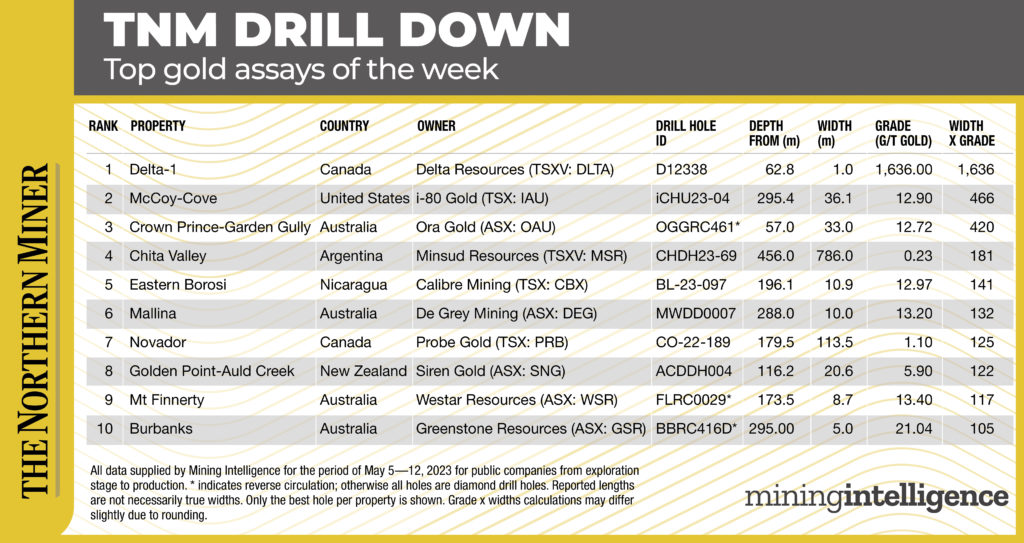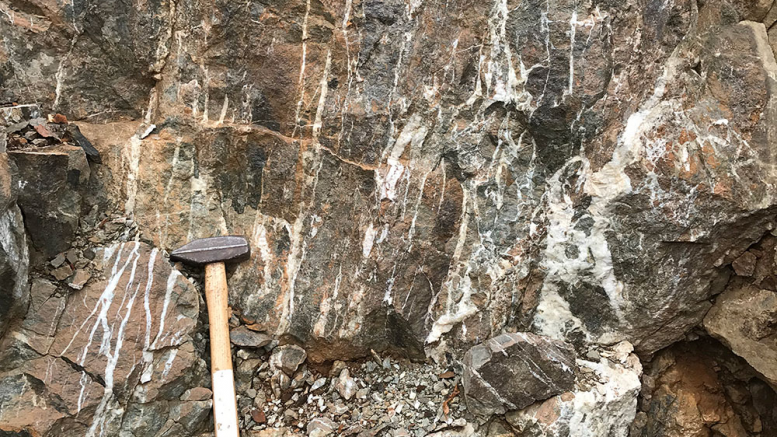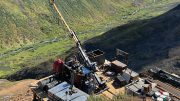Our TNM Drill Down features highlights of the top gold assays of the past week (May 5-12). Drill holes are ranked by gold grade x width, as identified by our data provider Mining Intelligence.

Last week’s top gold assays come from North America and Australia. Delta Resources (TSXV: DLTA) leads the rankings with its Delta-1 gold project in northwestern Ontario. On May 11, the Kingston, Ont.-based company reported that hole D1-23-38 returned 1 metre grading 1,636 grams gold per tonne from 62.8 metres depth for a grade x width value of 1,636. The hole cut “exceptionally high-grade gold mineralization” in narrower intervals east of a northeast-trending cross fault, the company said, though it’s not yet clear how the high-grade mineralization correlates with wide intervals of lower grade material west of the cross structure. The hole sits in a possible extension of the Eureka zone at Delta 1. “These Bonanza grades at Delta-1 are very impressive but more important is the fact that we are doing large, 100- metre step outs and are still consistently hitting strong alteration with higher-grade gold segments hosted within a broader zone of low to moderate grade gold,” said Delta president and CEO André Tessier. D1-23-38 was among the last four holes in Delta’s initial drill program this year at the 58.3-sq.-km project located 50 km west of Thunder Bay. The property had been dormant since 2003 until Delta optioned it and began exploration in 2019.
The second best assay of the week came from i-80 Gold’s (TSX: IAU) McCoy-Cove property in northern Nevada. On May 9, the company reported that drill hole iCHU23-04 cut 36.1 metres in the CSD Gap zone, grading 12.9 grams gold from 295.4 metres depth for a grade x width value of 466. Mineralization at the property, which saw historic production of 3.3 million oz. of gold, occurs in Carlin-like carbonate replacement deposits, polymetallic sheeted veins and skarn mineralization. “Our early results in the CSD Gap Zone confirm high-grade mineralization that makes Cove one of the highest-grade development-stage gold deposits in North America,” said CEO Ewan Downie. The highlight hole was part of a 40,000-metre delineation drill program aimed at upgrading resources in the Helen and CSD Gap zones before updating the Cove resource in preparation for a feasibility study. Cove hosts 1 million indicated tonnes grading 10.9 grams gold for 351,000 oz. contained metal, and 3.8 million inferred tonnes of the same grade for 1.3 million oz. gold, according to a preliminary economic assessment published in 2021.
The third best assay of the week came from Ora Gold’s (ASX: OAU) Garden Gully project in Western Australia. On May 8, the company reported that reverse-circulation (RC) hole OGGRC461 returned 33 metres grading 12.72 grams gold per tonne from 57 metres depth for a grade x width value of 420. The hole in the southeastern orebody of the Crown Prince prospect also cut 17 metres grading 24.4 grams gold from 67 metres depth and 73.5 grams gold from 71 metres depth. The drilling, part of a 2,965-metre program, is designed to test extensions of mineralized zones along strike of known mineralization and the down-dip potential of the main Crown Prince orebody. “The mineralisation to the southeast of [the main ore body] looks to be a continuous and coherent high-grade zone which is open at depth,” said Ora CEO Alex Passmore. “Due to the shallow, wide and high-grade nature of gold mineralisation present at the [southeastern ore body] it is likely to show robust economic outcomes in conceptual pit modelling.” A resource update released in 2019, put indicated resources at Crown Prince at 218,000 tonnes grading 4.3 grams gold per tonne for 30,000 oz. contained gold, and inferred resources at 261,000 tonnes grading 3.1 grams gold for 26,000 ounces. That estimate assumed a block cutoff grade of 1.2 grams gold per tonne. The company plans more RC and diamond drilling at the project.






Be the first to comment on "TNM Drill Down: Delta Resources’ namesake project in Ontario tops gold assays"